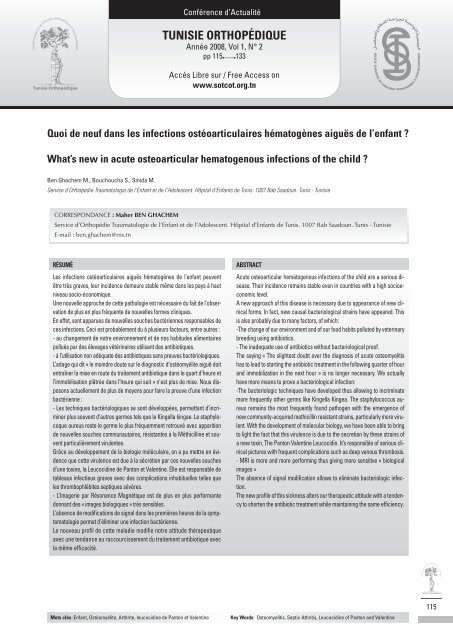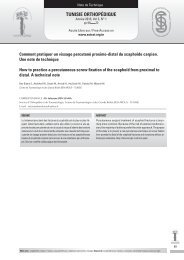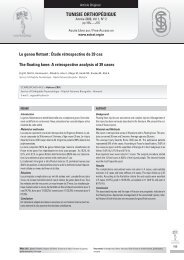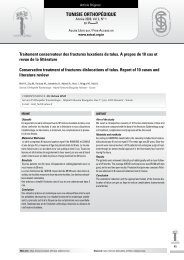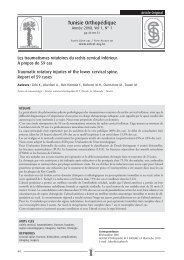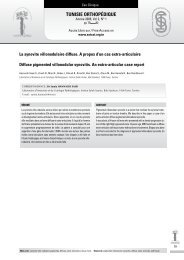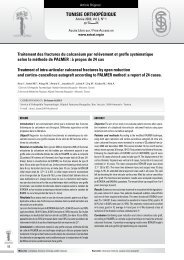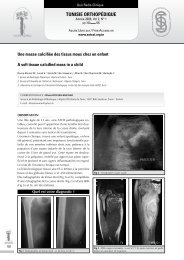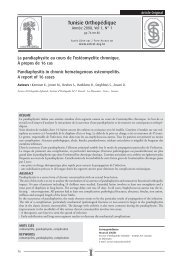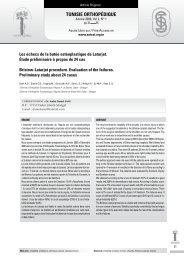Robert», la partie de l'art médical qui a pour objet - sotcot
Robert», la partie de l'art médical qui a pour objet - sotcot
Robert», la partie de l'art médical qui a pour objet - sotcot
Create successful ePaper yourself
Turn your PDF publications into a flip-book with our unique Google optimized e-Paper software.
Conférence d’ActualitéTunisie OrThOpédiqueAnnée 2008, Vol 1, N° 2pp 115 133Accés Libre sur / Free Access onwww.<strong>sotcot</strong>.org.tnquoi <strong>de</strong> neuf dans les infections ostéoarticu<strong>la</strong>ires hématogènes aiguës <strong>de</strong> l’enfant ?What’s new in acute osteoarticu<strong>la</strong>r hematogenous infections of the child ?Ben Ghachem M., Bouchoucha S., Smida M.Service d’Orthopédie Traumatologie <strong>de</strong> l’Enfant et <strong>de</strong> l’Adolescent. Hôpital d’Enfants <strong>de</strong> Tunis. 1007 Bab Saadoun. Tunis - TunisieCORRESPONDANCE : maher Ben GhaChemService d’Orthopédie Traumatologie <strong>de</strong> l’Enfant et <strong>de</strong> l’Adolescent. Hôpital d’Enfants <strong>de</strong> Tunis. 1007 Bab Saadoun. Tunis - TunisieE-mail : ben.ghachem@rns.tnrésuméLes infections ostéoarticu<strong>la</strong>ires aiguës hématogènes <strong>de</strong> l’enfant peuventêtre très graves, leur inci<strong>de</strong>nce <strong>de</strong>meure stable même dans les pays à hautniveau socio-économique.Une nouvelle approche <strong>de</strong> cette pathologie est nécessaire du fait <strong>de</strong> l’observation<strong>de</strong> plus en plus fréquente <strong>de</strong> nouvelles formes cliniques.En effet, sont apparues <strong>de</strong> nouvelles souches bactériennes responsables <strong>de</strong>ces infections. Ceci est probablement du à plusieurs facteurs, entre autres :- au changement <strong>de</strong> notre environnement et <strong>de</strong> nos habitu<strong>de</strong>s alimentairespollués par <strong>de</strong>s élevages vétérinaires utilisant <strong>de</strong>s antibiotiques.- à l’utilisation non adéquate <strong>de</strong>s antibiotiques sans preuves bactériologiques.L’adage <strong>qui</strong> dit « le moindre doute sur le diagnostic d’ostéomyélite aiguë doitentraîner <strong>la</strong> mise en route du traitement antibiotique dans le quart d’heure etl’immobilisation plâtrée dans l’heure <strong>qui</strong> suit » n’est plus <strong>de</strong> mise. Nous disposonsactuellement <strong>de</strong> plus <strong>de</strong> moyens <strong>pour</strong> faire <strong>la</strong> preuve d’une infectionbactérienne :- Les techniques bactériologiques se sont développées, permettant d’incriminerplus souvent d’autres germes tels que le Kingel<strong>la</strong> kingae. Le staphylocoqueaureus reste le germe le plus fréquemment retrouvé avec apparition<strong>de</strong> nouvelles souches communautaires, résistantes à <strong>la</strong> Méthicilline et souventparticulièrement virulentes.Grâce au développement <strong>de</strong> <strong>la</strong> biologie molécu<strong>la</strong>ire, on a pu mettre en évi<strong>de</strong>nceque cette virulence est due à <strong>la</strong> sécrétion par ces nouvelles souchesd’une toxine, <strong>la</strong> Leucocidine <strong>de</strong> Panton et Valentine. Elle est responsable <strong>de</strong>tableaux infectieux graves avec <strong>de</strong>s complications inhabituelles telles queles thrombophlébites septiques sévères.- L’Imagerie par Résonance Magnétique est <strong>de</strong> plus en plus performantedonnant <strong>de</strong>s « images biologiques » très sensibles.L’absence <strong>de</strong> modifications <strong>de</strong> signal dans les premières heures <strong>de</strong> <strong>la</strong> symptomatologiepermet d’éliminer une infection bactérienne.Le nouveau profil <strong>de</strong> cette ma<strong>la</strong>die modifie notre attitu<strong>de</strong> thérapeutiqueavec une tendance au raccourcissement du traitement antibiotique avec<strong>la</strong> même efficacité.ABsTrAcTAcute osteoarticu<strong>la</strong>r hematogenous infections of the child are a serious disease.Their inci<strong>de</strong>nce remains stable even in countries with a high socioeconomiclevel.A new approach of this disease is necessary due to appearance of new clinicalforms. In fact, new causal bacteriological strains have appeared. Thisis also probably due to many factors, of which:-The change of our environment and of our food habits polluted by veterinarybreeding using antibiotics.- The ina<strong>de</strong>quate use of antibiotics without bacteriological proof.The saying « The slightest doubt over the diagnosis of acute osteomyelitishas to lead to starting the antibiotic treatment in the following quarter of hourand immobilization in the next hour » is no longer necessary. We actuallyhave more means to prove a bacteriological infection:-The bacteriologic techniques have <strong>de</strong>veloped thus allowing to incriminatemore frequently other germs like Kingel<strong>la</strong> Kingea. The staphylococcus aureusremains the most frequently found pathogen with the emergence ofnew community-ac<strong>qui</strong>red methicillin resistant strains, particu<strong>la</strong>rly more virulent.With the <strong>de</strong>velopment of molecu<strong>la</strong>r biology, we have been able to bringto light the fact that this virulence is due to the secretion by these strains ofa new toxin, The Panton Valentine Leucocidin. It’s responsible of serious clinicalpictures with frequent complications such as <strong>de</strong>ep venous thrombosis.- MRI is more and more performing thus giving more sensitive « biologicalimages »The absence of signal modification allows to eliminate bacteriologic infection.The new profile of this sickness alters our therapeutic attitu<strong>de</strong> with a ten<strong>de</strong>ncyto shorten the antibiotic treatment while maintaining the same efficiency.mots clés :Enfant, Ostéomyélite, Arthrite, leucocidine <strong>de</strong> Panton et ValentineKey Words: Osteomyelitis, Septic Athritis, Leucocidine of Panton and Valentine115


